Watershed Drought and Ecosystem Services: Spatiotemporal Characteristics and Gray Relational Analysis
Abstract
:1. Introduction
2. Materials and Methods
2.1. Overview of the Study Area
2.2. Data Sources and Preprocessing
2.3. Research Methods
2.3.1. Gray Relational Analysis
- The evaluation criterion (reference sequence) and evaluation object (comparison sequence) were determined.
- The difference in absolute values was reduced by unifying the data into an approximate range, focusing on data changes and trends.
- The gray relational coefficient, ξi(k), was calculated aswhere ξi(k) is the correlation coefficient between reference sequence y(k) and several comparison sequences x1, x2, K, and xn at each moment; ρ is the distinguishing coefficient; usually ρ = 0.5.
- The gray relational degree, ri, was obtained as a quantitative expression of the degree of association between the reference and comparison sequences aswhere ri is the gray correlation degree.
- A correlation sequence of the evaluation subject was established according to the calculated value of the gray relational degree.
2.3.2. Drought Index Based on Remotely Sensed Data
2.3.3. Soil Conservation Services Assessment
2.3.4. Integration of Remotely Sensed NDVI into SWAT
2.3.5. Mann-Kendall Test
3. Results
3.1. Spatiotemporal Variations of Vegetation Cover and Evapotranspiration
3.1.1. Changes in Vegetation Cover
3.1.2. Changes in Evapotranspiration
3.2. Drought Assessment Based on ESI
3.3. Soil Conservation Services Simulation and Spatiotemporal Characteristics
3.3.1. Evaluation and Calibration of the Modified SWAT
3.3.2. Spatiotemporal Variations of Soil Conservation Services
3.4. Coupling Analysis of Soil Conservation Services and Drought
4. Discussion
5. Conclusions
- GRA has significant advantages in studying the factors affecting ESs. Soil conservation services in the YanHe Watershed are closely related to ESI and NDVI, followed by rainfall. Spatial variations exist in the correlations between soil conservation services and drought. In the middle and lower reaches of the YanHe River, drought in the regions covered by vegetation was aggravated with the enhancement of soil conservation services. The drought in parts of the mountainous area in the upper reaches of the YanHe River decreased with the enhancement of soil conservation services.
- From 2000 to 2015, with the implementation of the GFGP, vegetation status significantly improved, but plant water consumption increased with increasing ET. The average annual growth rate of NDVI in the entire basin was 0.0245 × 10a−1, whereas the growth rate of ET was 14.35 mm·a−1.
- Arid regions in the YanHe Watershed accounted for 63.86% of the total area, and the spatial distribution of drought increased from south to north. From 2000 to 2015, the overall distribution pattern of wet and dry conditions in the basin varied negligibly. Drought in parts of the midstream area of the YanHe River has been alleviated, while the humid regions have become drier.
- Vegetation restoration can effectively weaken soil erosion and improve the soil conservation functions of ecosystems. The SCM increased from 116.87 t·ha−1·a−1 (2000) to 412.58 t·ha−1·a−1 (2015), indicating a steady growth trend of 28.84 t·ha−1·a−1.
- The integration of remote sensing NDVI into SWAT enabled the fusion of remote sensing and non-remote sensing data, which enhanced the reliability of the original model and improved simulation accuracy.
Author Contributions
Funding
Institutional Review Board Statement
Informed Consent Statement
Data Availability Statement
Conflicts of Interest
References
- Daily, G.C. Nature’s Services: Societal Dependence on Natural Ecosystems; Island Press: Washington, DC, USA, 1997. [Google Scholar]
- Liu, Y.; Zhao, W.W.; Jia, L.Z. Soil conservation service: Concept, assessment, and outlook. Acta Ecol. Sin. 2019, 39, 432–440. (In Chinese) [Google Scholar]
- Yang, X.M.; Wang, F.; Bento, C.P.M.; Xue, S.; Gai, L.T.; Dam, R.V.; Mol, H.; Ritsema, C.J.; Geissen, V. Short-term transport of glyphosate with erosion in Chinese loess soil—A flume experiment. Sci. Total Environ. 2015, 512–513, 406–414. [Google Scholar] [CrossRef] [PubMed]
- Wang, F.; Mu, X.M.; Li, R.; Fleskens, L.; Stringer, L.C.; Ritsema, C.J. Co-evolution of soil and water conservation policy and human-environment linkages in the Yellow River Basin since 1949. Sci. Total Environ. 2015, 508, 166–177. [Google Scholar] [CrossRef] [PubMed] [Green Version]
- Allen, C.D.; Macalady, A.K.; Chenchouni, H.; Bachelet, D.; McDowell, N.; Vennetier, M.; Kitzberger, T.; Rigling, A.; Breshears, D.D.; Hogg, E.H.; et al. A global overview of drought and heat-induced tree mortality reveals emerging climate change risks for forests. For. Ecol. Manag. 2009, 259, 660–684. [Google Scholar] [CrossRef] [Green Version]
- Bennett, A.C.; McDowell, N.G.; Allen, C.D.; Anderson-Teixeira, K.J. Larger trees suffer most during drought in forests worldwide. Nat. Plants 2015, 1, 1–5. [Google Scholar] [CrossRef] [PubMed]
- Yao, N.; Li, Y.; Lei, T.J.; Peng, L.L. Drought evolution, severity and trends in mainland China over 1961–2013. Sci. Total Environ. 2018, 616, 73–89. [Google Scholar] [CrossRef]
- Dai, A. Increasing drought under global warming in observations and models. Nat. Clim. Chang. 2013, 3, 52–58. [Google Scholar] [CrossRef]
- Zhang, Z.X.; Chen, X.; Xu, C.Y.; Hong, Y.; Hardy, J.; Sun, Z.H. Examining the influence of river–lake interaction on the drought and water resources in the Poyang Lake basin. J. Hydrol. 2015, 522, 510–521. [Google Scholar] [CrossRef]
- Lesk, C.; Rowhani, P.; Ramankutty, N. Influence of extreme weather disasters on global crop production. Nature 2016, 529, 84–87. [Google Scholar] [CrossRef]
- Stagge, J.H.; Kohn, I.; Tallaksen, L.M.; Stahl, S. Modeling drought impact occurrence based on meteorological drought indices in Europe. J. Hydrol. 2015, 530, 37–50. [Google Scholar] [CrossRef]
- Guo, Z.L.; Huang, N.; Dong, Z.B.; Van Pelt, R.; Zobeck, T. Wind Erosion Induced Soil Degradation in Northern China: Status, Measures and Perspective. Sustain. Basel. 2014, 6, 8951–8966. [Google Scholar] [CrossRef] [Green Version]
- Kagabo, D.M.; Stroosnijder, L.; Visser, S.M.; Moore, D. Soil erosion, soil fertility and crop yield on slow-forming terraces in the highlands of Buberuka, Rwand. Soil Tillage Res. 2013, 128, 23–29. [Google Scholar] [CrossRef]
- Rienzi, E.A.; Fox, J.F.; Grove, J.H.; Matocha, C.J. Interrill erosion in soils with different land uses: The kinetic energy wetting effect on temporal particle size distribution. Catena 2013, 107, 130–138. [Google Scholar] [CrossRef]
- Krasa, J.; Dostal, T.; Jachymova, B.; Bauer, M.; Devaty, J. Soil erosion as a source of sediment and phosphorus in rivers and reservoirs-watershed analyses using WaTEM/SEDEM. Environ. Res. 2019, 171, 470–483. [Google Scholar] [CrossRef] [PubMed]
- Shi, Z.H.; Wang, L.; Liu, Q.J. Soil Erosion: From Comprehensive Control to Ecological Regulation. Bull. Chin. Acad. Sci. 2018, 33, 198–205. (In Chinese) [Google Scholar]
- Li, Z.Y.; Fang, H.Y. Impacts of climate change on water erosion: A review. Earth Sci. Rev. 2016, 163, 94–117. [Google Scholar] [CrossRef]
- Gao, J.L.; Zhang, J.G.; Zhu, L.L.; Ma, H.B.; Su, P.F.; Li, X. Change Characteristics of Key Measures of Soil and Water Conservation in Hill-gully Region of Loess Plateau. Bull. Soil Water Conserv. 2019, 39, 114–118. (In Chinese) [Google Scholar]
- Zhang, H.Y.; Fang, N.F.; Shi, Z.H. Spatio-temporal patterns for the NDVI and its responses to climatic factors in the Loess Plateau, China. Acta Ecol. Sin. 2016, 36, 3960–3968. (In Chinese) [Google Scholar]
- Zhang, B.Q.; Wu, P.T.; Zhao, X.N. Detecting and analysis of spatial and temporal variation of vegetation cover in the Loess Plateau during 1982–2009. Trans. Chin. Soc. Agric. Eng. 2011, 27, 287–293. (In Chinese) [Google Scholar]
- Zhao, X.; Wu, P.; Gao, X.; Persaud, N. Soil quality indicators in relation to land use and topography in a small catchment on the Loess Plateau of China. Land Degrad. Dev. 2015, 26, 54–61. [Google Scholar] [CrossRef]
- Bullock, A.; King, B. Evaluating China’s slope land conversion program as sustainable management in Tianquan and Wuqi Counties. J. Environ. Manag. 2011, 92, 1916–1922. [Google Scholar] [CrossRef] [PubMed]
- Zhang, K.; Lu, Y.H.; Fu, B.J. Vegetation restoration and its impact on ecosystem services in typical areas of the Loess Plateau. J. Ecol. Rural Environ. 2017, 33, 23–31. (In Chinese) [Google Scholar]
- Yang, B.; Wang, Q.J.; Xu, X.T. Evaluation of soil loss change after Grain for Green Project in the Loss Plateau: A case study of Yulin, China. Environ. Earth Sci. 2018, 77, 304. [Google Scholar] [CrossRef]
- Léa, K.; Romain, A.; Mathieu, S.; Jean-François, O.; Michel-Pierre, F. Plant functional trait effects on runoff to design herbaceous hedges for soil erosion control. Ecol. Eng. 2018, 118, 143–151. [Google Scholar]
- Gashaw, T.; Tulu, T.; Argaw, M.; Worqlul, A.W.; Tolessa, T.; Kindu, M. Estimating the impacts of land use/land cover changes on Ecosystem Service Values: The case of the Andassa watershed in the Upper Blue Nile basin of Ethiopia. Ecosyst. Serv. 2018, 31, 219–228. [Google Scholar] [CrossRef]
- Tobler, W.R. Computer movie simulating urban growth in the Detroit region. Econ. Geogr. 1970, 46, 234–240. [Google Scholar] [CrossRef]
- Shen, M.; Piao, S.; Jeong, S.J.; Zhou, L.M.; Zeng, Z.Z.; Ciais, P.; Chen, D.; Huang, M.T.; Jin, C.S.; Li, L.Z.X.; et al. Evaporative cooling over the Tibetan Plateau induced by vegetation growth. Proc. Natl. Acad. Sci. USA 2015, 112, 9299–9304. [Google Scholar] [CrossRef] [PubMed] [Green Version]
- Cao, X.C.; Wang, Y.B.; Wu, P.T.; Zhao, X.N.; Wang, J. An evaluation of the water utilization and grain production of irrigated and rain-fed croplands in China. Sci. Total Environ. 2015, 529, 10–20. [Google Scholar] [CrossRef]
- Shi, Y.F.; Liang, S.Q.; Peng, S.Z. Spatiotemporal Variation of Climate Drought in Loess Plateau Region during 1901–2017. Bull. Soil Water Conserv. 2020, 40, 283–289. (In Chinese) [Google Scholar]
- Wang, Y.S.; Li, X.Y.; Shi, F.Z.; Zhang, S.L.; Wu, X.L. The Grain for Green Project intensifies evapotranspiration in the revegetation area of the Loess Plateau in China. Chin. Sci. Bull. 2019, 64 (Suppl. Z1), 588–599. (In Chinese) [Google Scholar] [CrossRef] [Green Version]
- Ge, J.; Pitman, A.J.; Guo, W.D.; Zan, B.L.; Fu, C.B. Impact of revegetation of the Loess Plateau of China on the regional growing season water balance. Hydrol. Earth Syst. Sc. 2020, 24, 515–533. [Google Scholar] [CrossRef] [Green Version]
- Yuan, S.S.; Quiring, S.M. Drought in the U.S. Great Plains (1980–2012): A sensitivity study using different methods for estimating potential evapotranspiration in the Palmer Drought Severity Index. J. Geophys. Res. Atmos. 2014, 119, 10996–11010. [Google Scholar] [CrossRef]
- Vicente-Serrano, S.M.; Beguería, S.; López-Moreno, J.I. A Multiscalar Drought Index Sensitive to Global Warming: The Standardized Precipitation Evapotranspiration Index. J. Clim. 2010, 23, 1696–1710, 1712, 1714–1718. [Google Scholar] [CrossRef] [Green Version]
- Potop, V.; Možný, M.; Soukup, J. Drought evolution at various time scales in the lowland regions and their impact on vegetable crops in the Czech Republic. Agric. For. Meteorol. 2012, 156, 121–133. [Google Scholar] [CrossRef]
- Zhang, S.L.; Yang, D.W.; Yang, Y.T.; Piao, S.L.; Yang, H.B.; Lei, H.M.; Fu, B.J. Excessive Afforestation and Soil Drying on China’s Loess Plateau. J. Geophys. Res. Biogeo. 2018, 123, 923–935. [Google Scholar] [CrossRef]
- Wei, X.H.; Rao, X.J.; Kong, X.Y.; Ma, H.W. Research on drought monitoring based on remote sensing data. Hubei Agric. Sci. 2016, 55, 4598–4603. (In Chinese) [Google Scholar]
- Wang, W.; Huang, J.; Cui, W. Application comparison of drought indices in remote sensing monitoring of drought in Yunnan-Guizhou Plateau. Trans. Chin. Soc. Agric. Eng. 2018, 34, 131–139. (In Chinese) [Google Scholar]
- Otkin, J.A.; Haigh, T.; Mucia, A.; Anderson, M.C.; Hain, C.R. Comparison of agricultural stakeholder survey results and drought monitoring datasets during the 2016 U.S. Northern Plains flash drought Weather. Climate 2018, 10, 867–883. [Google Scholar]
- Yoon, D.H.; Nam, W.H.; Lee, H.J.; Hong, E.M.; Kim, T.; Shin, A.K.; Svoboda, M.D. Application of Evaporative Stress Index (ESI) for Satellite-based Agricultural Drought Monitoring in South Korea. J. Korean Soc. Agric. Eng. 2018, 60, 121–131. [Google Scholar]
- Liu, Y.Q.; Hao, L.; Zhou, D.C.; Pan, C.; Liu Pl Xiong, Z.; Sun, G. Identifying a transition climate zone in an arid river basin using the evaporative stress index. Nat. Hazard. Earth Sys. Sci. 2019, 19, 2281–2294. [Google Scholar] [CrossRef] [Green Version]
- Zhang, B.Q.; He, C.S.; Burnham, M.; Zhang, L.H. Evaluating the coupling effects of climate aridity and vegetation restoration on soil erosion over the Loess Plateau in China. Sci. Total Environ. 2016, 539, 436–449. [Google Scholar] [CrossRef] [PubMed]
- Hains-Young, R.; Potschin, M. The links between biodiversity, ecosystem services and human well-being. In Ecosystem Ecology: A New Systhsis; Raffaelli, D., Frid, C., Eds.; Cambridge University Press: Cambridge, UK, 2010. [Google Scholar]
- Daily, G.C.; Polasky, S.; Goldstein, J.; Kareiva, P.M.; Mooney, H.A.; Pejchar, L.; Ricketts, T.H.; Salzman, J.; Shallenberger, R. Ecosystem services in decision making: Time to deliver. Front. Ecol. Environ. 2009, 7, 21–28. [Google Scholar] [CrossRef] [Green Version]
- Zhou, Z.X. The Coupling Analysis of Landscape Pattern and Hydrological Process in YanHe Watershed. Ph.D. Thesis, Shaanxi Normal University, Xi’an, Shaanxi, China, 2014. (In Chinese). [Google Scholar]
- Yang, K.J.; Lu, C.H. Evaluation of land-use change effects on runoff and soil erosion of a hilly basin—The Yanhe River in the Chinese Loess Plateau. Land Degrad. Dev. 2018, 29, 1211–1221. [Google Scholar] [CrossRef]
- Gao, P.; Jiang, G.T.; Wei, Y.P.; Mu, X.M.; Wang, F.; Zhao, G.J.; Sun, W.Y. Streamflow regimes of the Yanhe River under climate and land use change, Loess Plateau, China. Hydrol. Process. 2015, 29, 2402–2413. [Google Scholar] [CrossRef]
- Rehman, E.; Ikram, M.; Feng, M.T.; Rehman, S. Sectoral-based CO2 emissions of Pakistan: A novel Grey Relation Analysis (GRA) approach. Environ. Sci. Pollut. R. 2020, 27, 29118–29129. [Google Scholar] [CrossRef]
- Deng, J.L. Basic method of grey system. Huazhong Inst. Technol. Press 1987, 11, 1–24. (In Chinese) [Google Scholar]
- Anderson, M.C.; Hain, C.; Wardlow, B.; Pimstein, A.; Mecikalski, J.R.; Kustas, W.P. Evaluation of Drought Indices Based on Thermal Remote Sensing of Evapotranspiration over the Continental United States. J. Clim. 2011, 24, 2025–2044. [Google Scholar] [CrossRef]
- Zhou, J.; He, D.; Xie, Y.F.; Liu, Y.; Yang, Y.H.; Sheng, H.; Guo, H.C.; Zhao, L.; Zou, R. Integrated SWAT model and statistical downscaling for estimating streamflow response to climate change in the Lake Dianchi watershed, China. Stoch. Env. Res. Risk. Assess. 2015, 29, 1193–1210. [Google Scholar] [CrossRef]
- Chen, D.S.; Li, J.; Zhou, Z.X.; Liu, Y.; Li, T.; Liu, J.Y. Simulating and mapping the spatial and seasonal effects of future climate and land -use changes on ecosystem services in the Yanhe watershed, China. Environ. Sci. Pollut. Res. 2018, 25, 1115–1131. [Google Scholar] [CrossRef]
- Yan, R.; Zhang, X.Q.; Yan, X.J.; Zhang, J.J.; Chen, H. Spatial patterns of hydrological responses to land use/cover change in a catchment on the Loess Plateau, China. Ecol. Indic. 2018, 92, 151–160. [Google Scholar] [CrossRef]
- Zhang, L.; Karthikeyan, R.; Bai, Z.; Srinivasan, R. Analysis of streamflow responses to climate variability and land use change in the Loess Plateau region of China. Catena 2017, 154. [Google Scholar] [CrossRef]
- Ren, Z.P.; Feng, Z.H.; Li, P.; Wang, D.; Cheng, S.D.; Gong, J.F. Response of runoff and sediment yield from climate change in the Yanhe Watershed, China. J. Coastal. Res. 2017, 30–35. [Google Scholar] [CrossRef]
- Abbaspour, K.C.; Rouholahnejad, E.; Vaghefi, S.; Srinivasan, R.; Yang, H.; Kløve, B. A continental-scale hydrology and water quality model for Europe: Calibration and uncertainty of a high-resolution large-scale SWAT model. J. Hydrol. 2015, 524, 733–752. [Google Scholar] [CrossRef] [Green Version]
- Meaurio, M.; Zabaleta, A.; Uriarte, J.A.; Srinivasan, R.; Antigüedad, I. Evaluation of SWAT models performance to simulate streamflow spatial origin. The case of a small forested watershed. J. Hydrol. 2015, 525, 326–334. [Google Scholar] [CrossRef]
- Chen, D.S.; Li, J.; Yang, X.N.; Zhou, Z.X.; Pan, Y.Q.; Li, M.C. Quantifying water provision service supply, demand and spatial flow for land use optimization: A case study in the YanHe watershed. Ecosyst. Serv. 2020, 43, 101117. [Google Scholar] [CrossRef]
- Li, J.; Zhou, Z.X. Landscape pattern and hydrological processes in YanHe River basin of China. Acta Geogr. Sin. 2014, 69, 933–944. (In Chinese) [Google Scholar]
- Jiang, C.L.; Zhang, L.J.; Zhang, H.W.; Jiang, C.Y.; Yu, Y.; Pan, T. Quantitative evaluation of soil conservation in 2000–2010 in Heilongjiang Province using RUSLE model. Chin. J. Eco Agric. 2015, 23, 642–649. (In Chinese) [Google Scholar]
- Liu, J.M.; Yuan, D.; Zhang, L.P.; Zou, X.; Song, X.Y.; Gelfan, A. Comparison of Three Statistical Downscaling Methods and Ensemble Downscaling Method Based on Bayesian Model Averaging in Upper Hanjiang River Basin, China. Adv. Meteorol. 2015, 2016. [Google Scholar] [CrossRef]
- Ma, T.X.; Duan, Z.; Li, R.K.; Song, X.F. Enhancing SWAT with remotely sensed LAI for improved modelling of ecohydrological process in subtropic. J. Hydrol. 2019, 570, 802–815. [Google Scholar] [CrossRef] [Green Version]
- Van der Knijff, J.M.; Jones, R.J.A.; Montanarella, L. Soil Erosion Risk Assessment in Europe; EUR 19044 EN; Office for Publications of the European Communities: Luxembourg, 2000. [Google Scholar]
- Van Leeuwen, W.J.D.; Sammons, G. Vegetation dynamics and erosion modeling using remotely sensed data (MODIS) and GIS. In Proceedings of the Tenth Biennial USDA Forest Service Remote Sensing Applications Conference, Salt Lake City, UT, USA, 5–9 April 2004. [Google Scholar]
- Mann, H.B. Nonparametric tests against trend. Econometrica 1945, 13, 245259. [Google Scholar] [CrossRef]
- Wang, Z.J. Research on the Characteristics of Vegetation and Erosion and Sediment Yield in the Yanhe River Basin. Ph.D. Thesis, Graduate School of the Chinese Academy of Sciences (Soil Conservation and Ecological Environment Research Center of the Ministry of Education), Beijing, China, 2014. (In Chinese). [Google Scholar]
- Chen, H. Research on the Spatial and Temporal Changes and Driving Factors of Soil Erosion in the Watershed before and after Returning Farmland to Forest on the Loess Plateau. Ph.D. Thesis, Northwest Sci-tech University of Agriculture and Forestry, Yangling, Shaanxi, China, 2019. (In Chinese). [Google Scholar]
- Zhang, B.Q.; Wu, P.T.; Zhao, X.N.; Wang, Y.B.; Gao, X.D. Changes in vegetation condition in areas with different gradients (1980–2010) on the Loess Plateau, China. Environ. Earth Sci. 2013, 68, 2427–2438. [Google Scholar] [CrossRef]
- Shao, R.; Zhang, B.Q.; Su, T.X.; Long, B.; Cheng, L.Y.; Xue, Y.Y.; Yang, W.J. Estimating the Increase in Regional Evaporative Water Consumption as a Result of Vegetation Restoration Over the Loess Plateau, China. J. Geophys. Res. Atmos. 2019, 124, 11783–11802. [Google Scholar] [CrossRef]
- Mokhtar, A.; He, H.; Alsafadi, K.; Li, Y.; Zhao, H.F.; Keo, S.; Bai, C.Y.; Abuarab, M.; Zhang, C.J.; Elbagoury, K.; et al. Evapotranspiration as a response to climate variability and ecosystem changes in southwest, China. Environ. Earth Sci. 2020, 79, 1–21. [Google Scholar] [CrossRef]
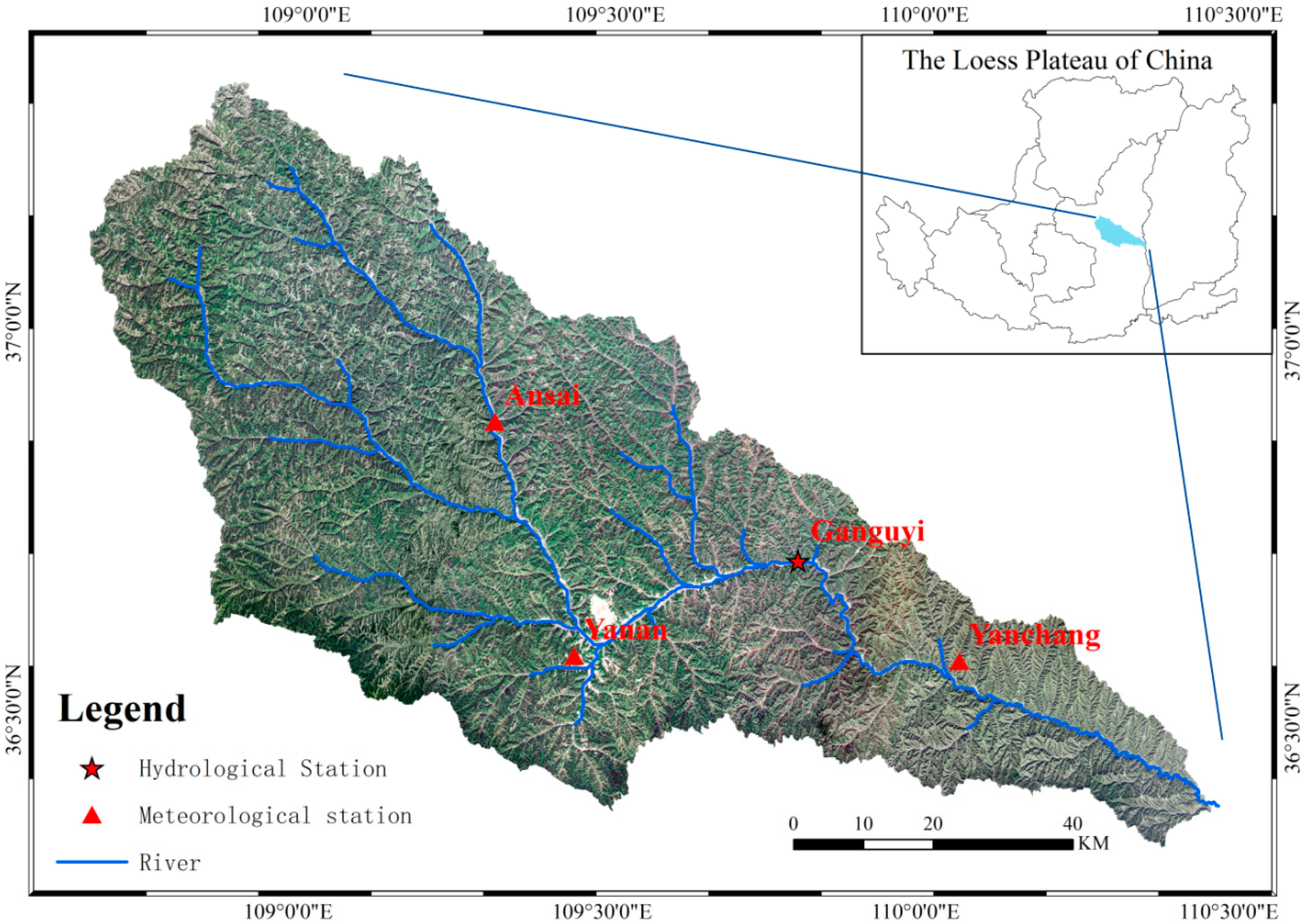
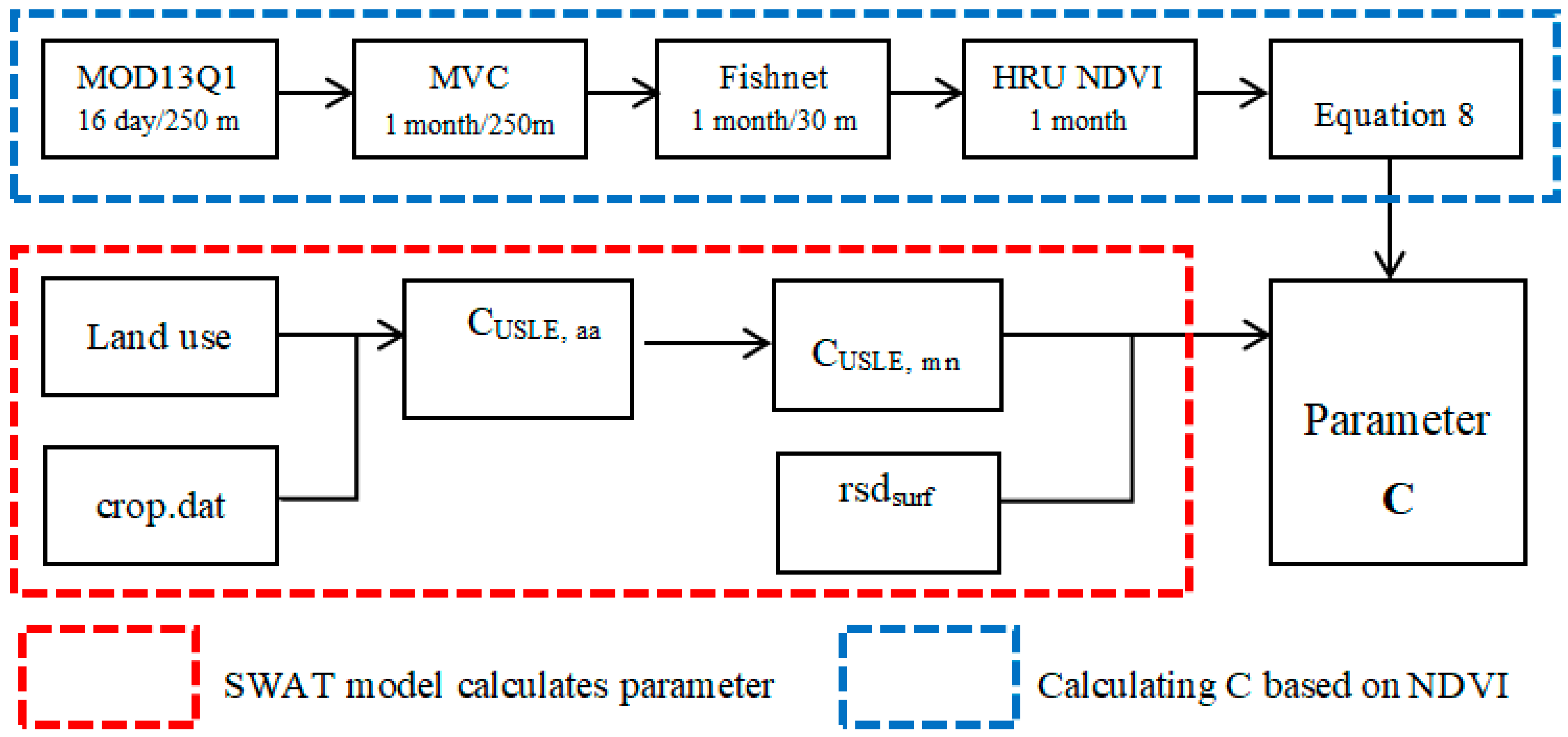
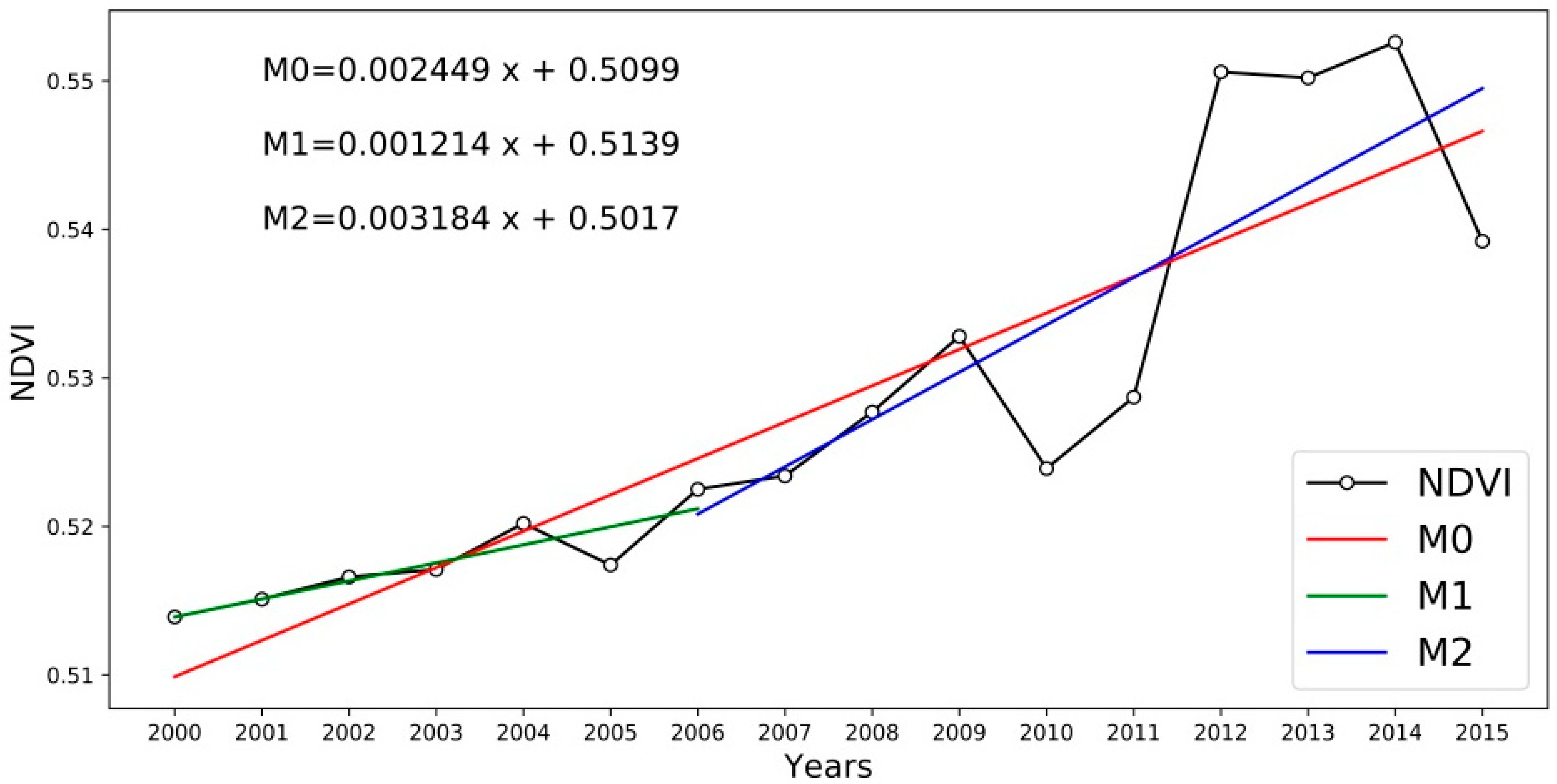

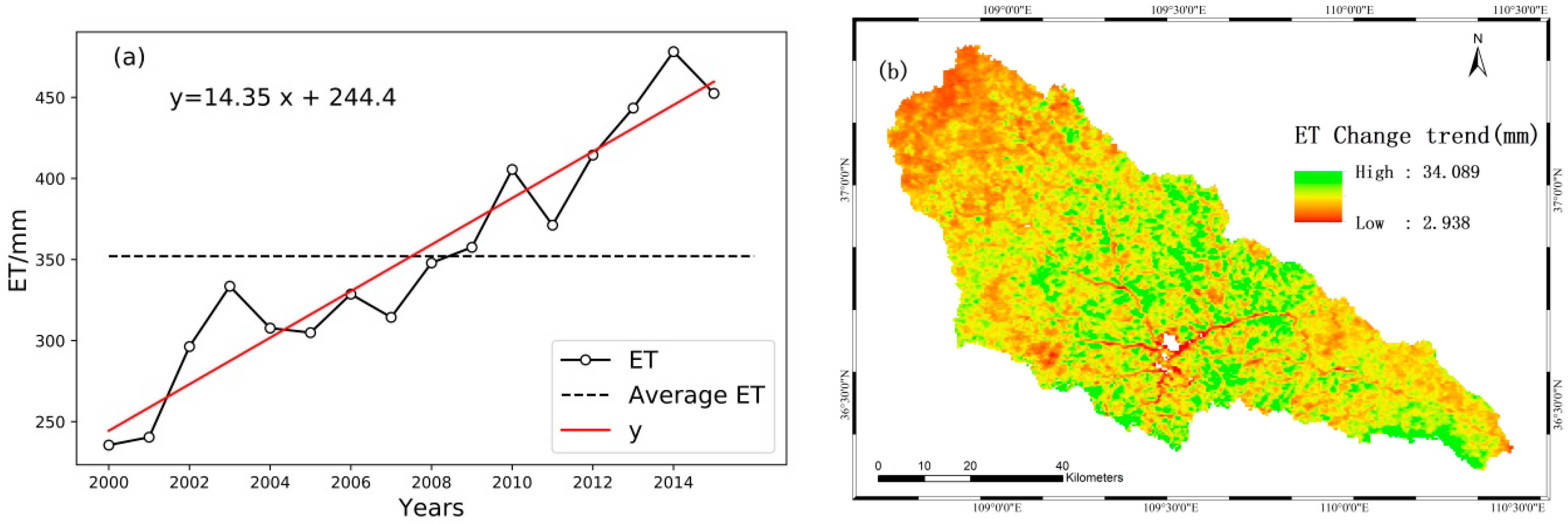
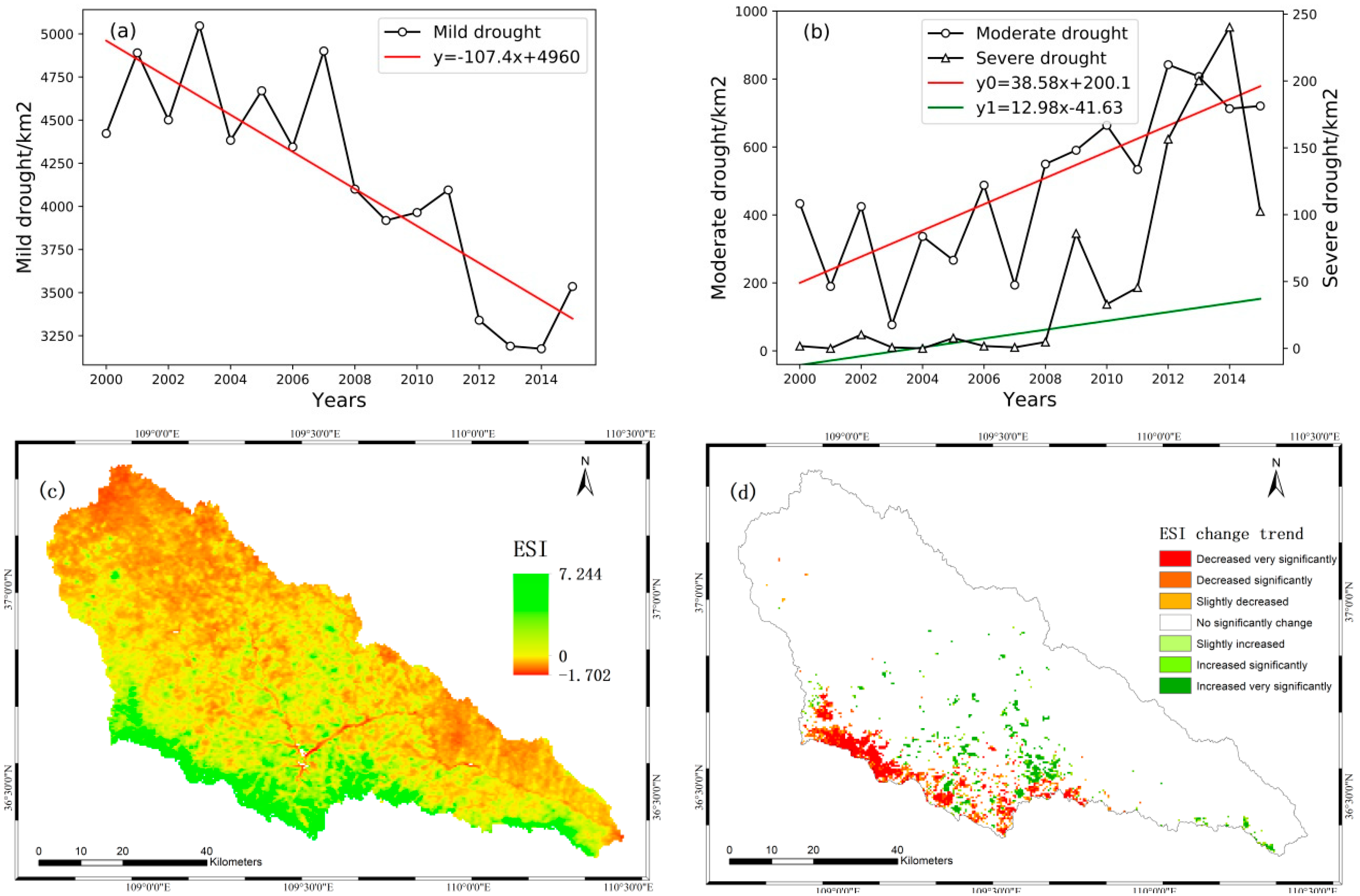
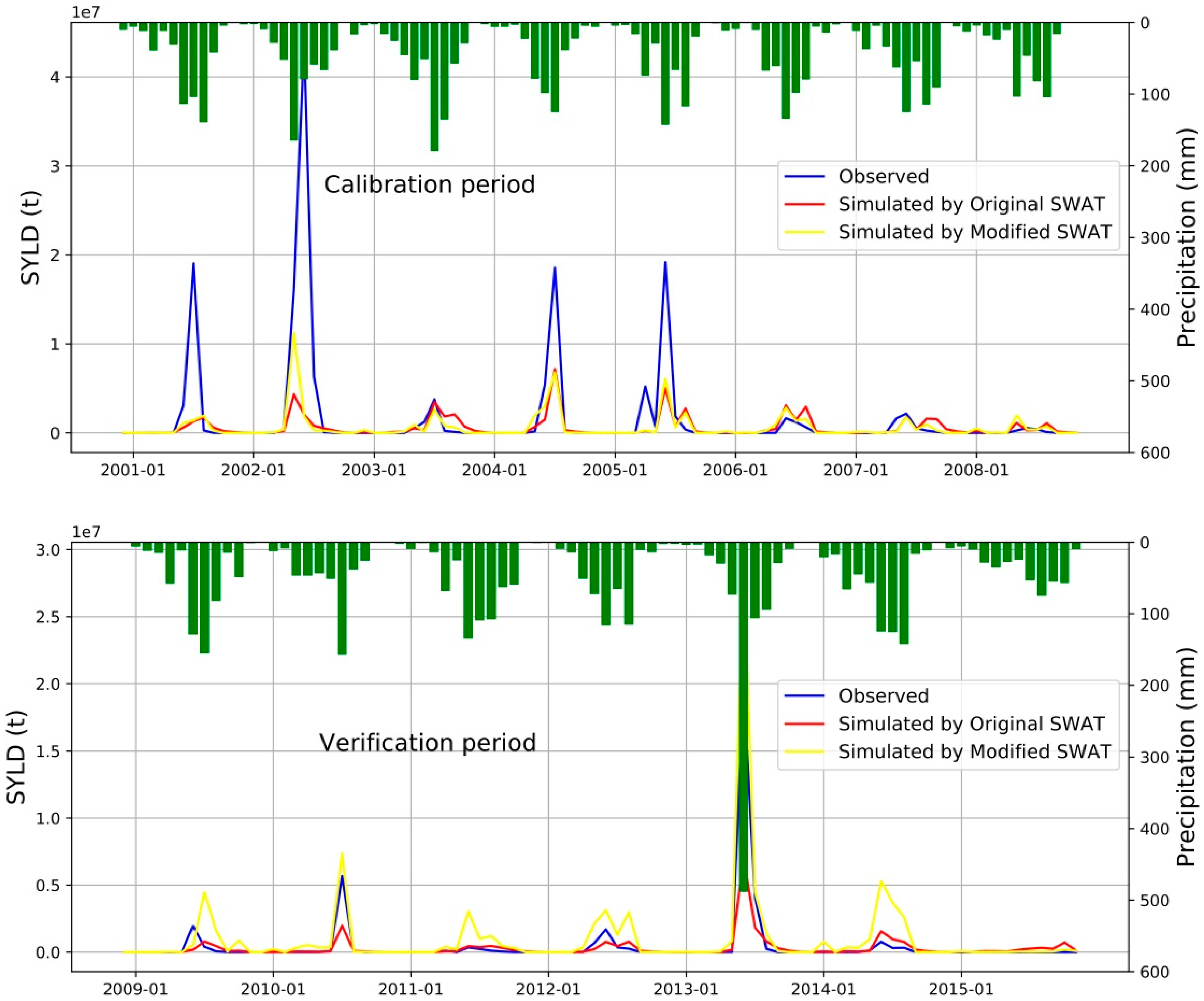

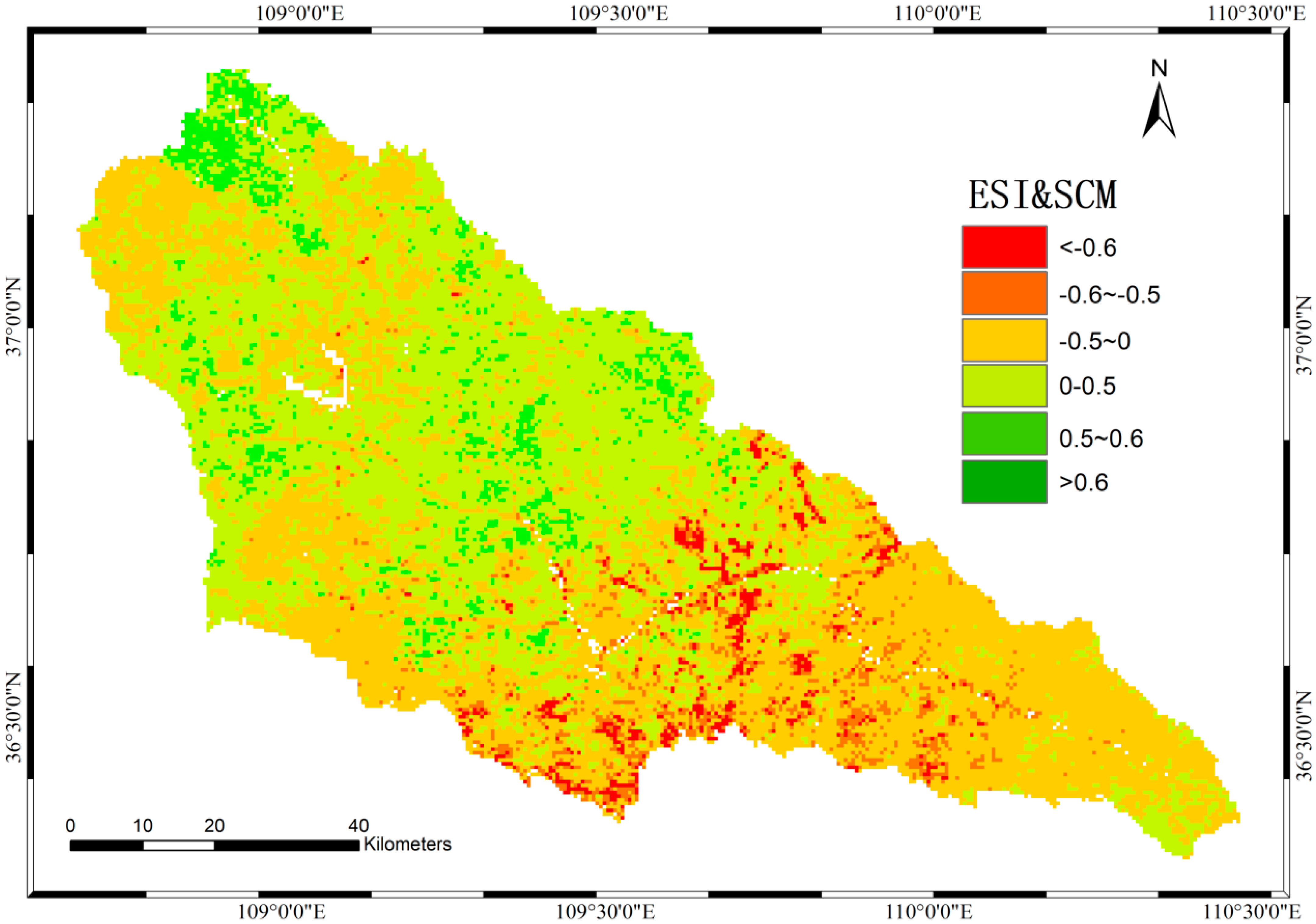
| ESI | Drought Category |
|---|---|
| ESI ≥ 0 | – |
| −1.0 < ESI < 0 | Mild drought |
| −1.5 < ESI ≤ −1.0 | Moderate drought |
| −2.0 < ESI ≤ −1.5 | Severe drought |
| ESI ≤ −2.0 | Extreme drought |
| τ | p-Value | Trend Type | Trend Features |
|---|---|---|---|
| p ≤ 0.01 | 3 | Increased very significantly | |
| τ > 0 | 0.01 < p ≤ 0.05 | 2 | Increased significantly |
| 0.05 < p ≤ 0.1 | 1 | Slightly increased | |
| τ = 0 | 0 | No significant change | |
| 0.05 < p ≤ 0.1 | –1 | Slightly decreased | |
| τ < 0 | 0.01 < p ≤ 0.05 | –2 | Decreased significantly |
| p ≤ 0.01 | –3 | Decreased very significantly |
| RESI | RNVDI | RPCP | RRH | RWIND | RTEM |
|---|---|---|---|---|---|
| 0.9779 | 0.9766 | 0.9714 | 0.9552 | 0.7515 | 0.7273 |
Publisher’s Note: MDPI stays neutral with regard to jurisdictional claims in published maps and institutional affiliations. |
© 2021 by the authors. Licensee MDPI, Basel, Switzerland. This article is an open access article distributed under the terms and conditions of the Creative Commons Attribution (CC BY) license (http://creativecommons.org/licenses/by/4.0/).
Share and Cite
Bai, J.; Zhou, Z.; Zou, Y.; Pulatov, B.; Siddique, K.H.M. Watershed Drought and Ecosystem Services: Spatiotemporal Characteristics and Gray Relational Analysis. ISPRS Int. J. Geo-Inf. 2021, 10, 43. https://0-doi-org.brum.beds.ac.uk/10.3390/ijgi10020043
Bai J, Zhou Z, Zou Y, Pulatov B, Siddique KHM. Watershed Drought and Ecosystem Services: Spatiotemporal Characteristics and Gray Relational Analysis. ISPRS International Journal of Geo-Information. 2021; 10(2):43. https://0-doi-org.brum.beds.ac.uk/10.3390/ijgi10020043
Chicago/Turabian StyleBai, Jizhou, Zixiang Zhou, Yufeng Zou, Bakhtiyor Pulatov, and Kadambot H. M. Siddique. 2021. "Watershed Drought and Ecosystem Services: Spatiotemporal Characteristics and Gray Relational Analysis" ISPRS International Journal of Geo-Information 10, no. 2: 43. https://0-doi-org.brum.beds.ac.uk/10.3390/ijgi10020043





